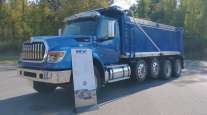Navistar Reports 1Q Loss; Says Order Pace Improving
This story appears in the March 10 print edition of Transport Topics.
Navistar International Corp. last week reported that its fiscal first-quarter loss more than doubled to $248 million as sales slowed, but the truck maker said recent strong activity points to better times ahead.
The loss for the quarter ended Jan. 31 widened from $123 million, and revenue slipped 16% to $2.21 billion from $2.64 billion. On a per share basis, the loss was $3.07 in the most recent quarter and $1.42 in the year-ago period.
“We told you we would face some challenges in the first quarter,” CEO Troy Clarke said, citing costs related to launching medium-duty trucks and slowing sales to the U.S. military as overseas conflicts wind down.
“Our sales are trending upward,” Clarke added on a conference call. “We are encouraged by our stronger backlog. We have put the pieces in place to recover [market] share. Now that we have products to sell, the pace of change will accelerate.”
The North American truck business posted a $207 million loss, more than double the prior year period. Sales fell 18% in that unit, the company’s largest.
Parts profitability dropped to $104 million, a 12% decline. Global operations’ loss more than tripled to $33 million, hurt by lower sales in South America and unfavorable currency exchange rate changes. Financial services’ profit rose 4% to $23 million.
One indicator of the slowing military sales market was the fact that there were no military vehicles invoiced in the first quarter. In the 2013 fiscal year, the total was 800, down half from the 1,600 in the 2012 fiscal year.
Chief Operating Officer Jack Allen said business improved in January and projected it will improve further.
Labeling that month “a strong bounce-back,” he said January’s market share was the highest in six months at 18%. For the quarter, it was 14%. That total includes heavy trucks and severe-service trucks.
The truck and bus order backlog was 56% higher Jan. 31 than the same month in 2013, he said.
“We are gaining momentum in the marketplace,” Allen said, noting that competitors’ aggressive year-end 2013 pricing was a factor in market-share levels during November and December.
As a result of improving orders last month, Allen also said, truck production in the second quarter will be 25% to 30% higher than the first quarter and 20% to 25% better year-over-year.
Robert W. Baird analyst David Leiker said in a report that Navistar’s outlook includes a solid second-quarter performance with a “meaningful year-over-year sequential production increase.”
The Lisle, Ill.-based company continues to project Class 8 retail sales for the United States and Canada in the 220,000-230,000 range.
However, Allen also said, “Recent order rates indicate there might be some upside” because of increased freight volumes and profits.
Earnings before interest, taxes, depreciation and amortization, or EBITDA, showed a $110 million loss, which included $52 million in adjustments for pre-existing warranty costs and $21 million in one-time charges.
Clarke forecast that EBITDA would be between $25 million and $75 million in the second quarter, also excluding warranty and one-time costs. In the prior year second quarter, EBITDA was a $116 million loss.
The company also is on track to meet its goal of an EBITDA margin of between 8% and 10% by the end of next year, Clarke said.
The number of trucks charged out, or invoiced to customers worldwide, included a 22% drop in the medium-duty market. Class 8 trucks invoiced fell 2% to 4,500 from the prior-year period.
Engine shipments fell 26% to 32,700 in the most recent quarter, including a 42% drop in engines manufactured for Navistar trucks.
The company will begin producing trucks with MaxxForce 9- and 10-liter engines in the summer to build medium-duty market share, Allen said, using selective catalytic reduction aftertreatment.
In addition, Navistar will keep selling those trucks with exhaust gas recirculation aftertreatment as an alternative because emissions credits continue to be available for that equipment.
Allen also said the used truck market was strong in the quarter.




